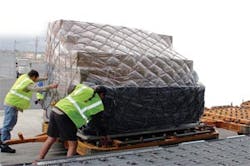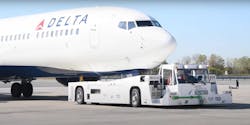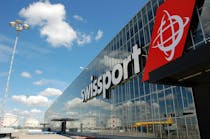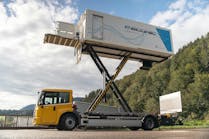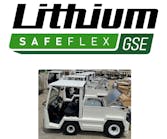UPS has been selected to receive funding from the U.S. Environmental Protection Agency to support two separate sustainability projects related to the airline’s ground operations at its Worldport hub in Louisville, Ky. The development is one of the latest in a long line of environmental initiatives from the company.
GOVERNMENT GREEN
In February, it was announced that UPS had been selected as the recipient of an EPA Region IV National Clean Diesel Campaign Grant for the voluntary reduction of diesel exhaust particulates. In accordance with funding requirements, Kentucky Clean Fuels Coalition — a not-for-profit agency in the state that promotes clean fuels and alternative technologies — applied for the grant on behalf of UPS, which is a member of the group.
Following a written proposal — which was done in partnership between the Kentucky Clean Fuels Coalition, Kentucky Division for Air Quality and UPS — the airline was chosen by the EPA to receive $473,939 to fund two separate projects. In one project UPS will be repowering 92 10-year-old diesel tugs with new 2.8-liter, four-cylinder gasoline engines. In the second project, UPS will implement electrical units that will supply parked aircraft with ground power from the building, eliminating the need for 26 mobile diesel GPUs, according to the company.
According to Melissa Howell, executive director of the Kentucky Clean Fuels Coalition, the program was a good fit for the company. “The fact that UPS is a leader in research and development of transportation technologies made this, I think, an interesting project,” she says. “Because it’s something that others could look at and duplicate.”
SETTING THE EXAMPLE
In its 2007 corporate sustainability report, UPS made clear its intent to support more environmentally sound practices: “We conduct our business and operations with consideration for their environmental impact. Our responsibility for the environment ranges from the construction, maintenance and operation of our facilities, to the maintenance and operation of our vehicles and aircraft, to the conservation of resources.”
The company’s work toward more environmentally sound practices began in the 1930s when it introduced an electric on-road delivery vehicle to its fleet. Today the company boasts one of the largest private alternative-fuel fleets in the industry, implementing several types of alternative technologies in its on-road vehicles including CNG, LNG, propane, electric hybrid and fuel cell technology.
As the 9th largest airline in the world, UPS operates about 7,000 pieces of GSE throughout its network.
A “rolling laboratory approach” has led the company to continuously evaluate new technology and that work has been incorporated into the GSE of its airline fleet. In addition to the EPA-funded program, UPS has implemented more than 40 pieces of electric GSE in California. At other locations it has implemented propane-powered and newer gasoline tugs and belt loaders.
A SIZEABLE OPERATION
As the cargo airline’s hub, Worldport in Louisville, Ky, is grand in its scale. It employs about 8,000 people and fields about 250 inbound and outbound flights a day. The ramp is 130 acres with 123 aircraft parking positions. The sorting hub facility is 4 million square feet with the capacity to process 304,000 packages per hour.
To support such an operation, UPS has more than 660 tugs at its Worldport facility. The majority of the tugs are gasoline-powered. When considering which technology to employ in its tugs with the funding, the ability of the engines to support the cargo operation was a primary concern. “From a cargo standpoint, in Louisville where we are going to do this conversion, it’s a very, very large facility,” says Bill Jacob, vice president of airline ground support equipment at UPS and a member of the board of directors at the Kentucky Clean Fuels Coalition. “Louisville is 130 acres of campus, so there is a lot of driving. Gasoline was the best-suited power plan for the work load that it had to perform.
“Also, this particular gasoline engine has been certified to California LSI standards,” he adds, “so not only are we going to a gasoline engine, we are going to a gasoline engine that meets California’s LSI rule, so it’s very, very clean.”
Jacob continues, “The other thing with the engine that we’re putting into these tugs — the 2.8-liter — it gets 34 percent better fuel consumption than the six-cylinder engine it replaces, so we actually are lowering our carbon footprint as well as lowering our emissions.”
With 2,200 tugs across the UPS network, the majority of which are gasoline, Jacob says the plan to bring older engines up to par is to repower on an as-needed basis. “As engines fail, we will upgrade them to the newer technology,” he says.
“We look at a tug as a piece of equipment that has a very long life, because the parts on it that fail are the engine, transmission and differential,” Jacob says. “The tugs they build nowadays, aside from the new engines, are the same tugs you bought 20 years ago, so you’re buying the steel again as you dispose of it.”
GREENER PASTURES
The work toward more sustainable practices continues for UPS. Jacob says the company is looking at myriad ways to incorporate alternative technology into its fleet, including replacing the engines in some of its GPUs and belt loaders. “We are looking at converting belt loader engines — both gas and diesel — to the small gas engine, because having a six-cylinder engine in a belt loader, which was all the industry offered pretty much in gasoline years ago, it just doesn’t make sense,” he says. “You don’t need to put a large power plant in a belt loader.”
Jacob says the company is also considering converting some of its cargo loaders to electric.
“The movement of 15.5 million packages around the world each day requires operating large ground and air fleets,” Jacob says. “Therefore, reducing fuel use and emissions is a constant priority and challenge. Our long-term goal is to reduce our dependence on fossil fuels by improving operational efficiencies and advancing new technologies.”
